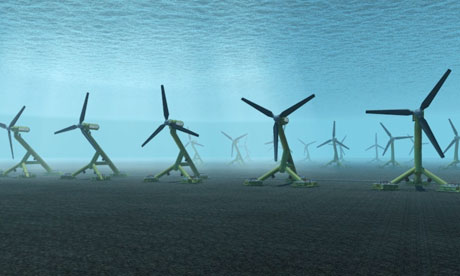Tidal energy – the UK's best kept secret
Posted by Big Gav in ocean energy, tidal power, uk
The Guardian has an article on the potential for tidal power in the UK - Tidal energy – the UK's best kept secret.
The latest report on Renewables from the Committee on Climate Change (CCC) offers lukewarm support for electricity generation from tidal streams. The UK has some of the fiercest tidal currents in the world, but the CCC says the tidal turbines will deliver energy at a higher cost than PV in 2040. The assumptions behind this pessimism are questioned in this article.
The tides around Britain's coasts sweep huge volumes of water back and forth at substantial speeds. The energy contained in the tidal races off the west of the UK is as great as anywhere in the world. Because water is a thousand or so times heavier than air, the maximum speeds of perhaps 6 metres a second are capable of generating far more electricity per square metre of turbine area than a windmill. The Pentland Firth, the narrow run of water between the north-east tip of Scotland and the Orkney islands, is possibly the best place in the world to turn racing tides into electricity. The challenges are immense: massive steel structures need to be made that survive huge stresses, day after day.
The rewards for tidal stream developers are commensurate. Unlike other renewable technologies, tidal power is utterly predictable for the entire life of a turbine. We know to the minute when the tides on a particular day will be at their peak. Once installed, the running costs of tidal stream technology will be low. The environmental impact of tidal turbines appears to be very small. And the UK could probably provide a quarter of its electricity from tides. (And much more if an environmentally acceptable means was found of damming the Severn tides).
The CCC might then have been expected to push for a significant programme of support for tidal. Its reservations appear to be as follows.
a) Tidal generation does not help with the 'intermittency' problem of renewables generation.
b) The levels of yield are relatively low. (Yield is the percentage of rated power that can be delivered in a typical day.)
c) The cost of capital is high for a developer using tidal turbines because of the risk of the technology not working
d) The relatively small scope for learning curve improvements.
Intermittency
An individual tidal turbine will generate most electricity when the tide is running fastest. This will be at approximately the mid point between high and low tides. The CCC therefore says that tidal power will not help deal with periods of low production.
The cycle of marine power (tidal plus wave) suggests that total output will fall to zero four times a day. This would only be the case if all the turbines were sited at the same place. Turbines placed, as they will be, all around the coasts of Great Britain will generate maximum power at different times of the day. On the day I looked at the tide tables, the tides in the Channel Islands (where there are some extremely powerful races) were completely unsynchronised with the tides in northern Scotland. Two turbines, one off Alderney, one off John O'Groats, would together produce substantial amounts of (entirely predictable) power every second of the day. Tidal power is as dispatchable as nuclear.
Yields are low
The CCC offers a view as to the output of a tidal turbine, suggesting that in a 'high' case the figure will be 40%. That is, the average electricity output of a 1MW turbine over the course of a year will be 400kW.
Actually, the one piece of reliable data on this number suggests a much higher figure. The UK's hugely impressive tidal turbine developer, Marine Current Turbines (MCT), has had a device in the waters of Strangford Lough for several years. This early turbine has produced 50% of its rated power. The difference is important: it means that electricity generation costs are 25% lower than the CCC would otherwise have predicted.






